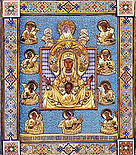“The Memory of the Confessors Compels Us” – an article by Hieromonk Ignatious (Krutkov)
The Memory of the Confessors Compels Us
September 26th is the anniversary of the righteous death of the Catacomb Church confessor, Fr. Mikhail Rozhdestvennskiy. This good shepherd of the clandestine Russian Church was vested to the priesthood by Martyr-Saint Metropolitan Iosif of Petrograd in 1925. One year later, Fr. Mikhail proved himself as a confessor by signing the act that separated the Petrograd clergy from Metropolitan Sergey (Stragorodskiy) after the latter issued the sadly, well-known Declaration of 1927. A year later at the age of 28, this valiant soldier of Christ was arrested and served, as was then said his first “dime” or ten-year sentence, on the construction of the White Sea Canal. In 1943 he was again arrested in St. Petersburg on charges of illegal residence and for holding secret religious services, for which he received a second term in the Vorkuta prison camps. After enduring this crucible of war sieges and prison camps, and with his health ruined, he was judged to have a “degenerative condition,” and in 1955 was paroled to his son in Pechora, where he continued conducting secret religious services, visiting the faithful of the Catacomb Church in St. Petersburg, Voronezh and the whole of Russia. Fr. Mikhail concluded his pastoral Calvary in 1988 on the feast day of the Exaltation of the Holy Cross.
Fr. Mikhail’s closest assistant, Aleksandra Feodorovna Panyushina (d. 2004), in whose house near St. Petersburg he lived and held religious services, told me that in the last years of his ministry Fr. Mikhail commemorated Bishop Lazar (Zhurbenko). As we know, Bishop Lazar, in a decision of the ROCA Synod under St. Filaret (Voznesenskiy), was secretly vested a bishop on the territory of Russia to care for communities of the Catacomb Church. The hierarchy of the Russian Church Abroad took this step also as a result of the rise of pseudo-Catacomb Church organizations in Russia. For example, in addressing the followers of the so-called “Schema-Metropolitan” Gennadiy (Sekach), the ROCA Council of Bishops in its ruling of 2 (15) May 1990, in Protocol № 6 stated: “The Council cannot recognize the canonicity of ordinations of this catacomb group.” The ROCA Synod of Bishops also addressed the issue of the absence of canonical hierarchical succession in this group and declared in 1990 that “in light of the lack of (or the failure to provide) proper evidence of valid apostolic succession we cannot recognize as canonical the ordinations of these clandestine hierarchies.” Further, “the ROCA Synod of Bishops determines that the clergy (priests and deacons) who were vested in the above group and who wish to enter into communion with the
Russian Orthodox Church Abroad, must settle their canonical status through vestiture (if they face no canonical obstacles) from a bishop recognized by the Russian Orthodox Church Abroad,” (Chancellery of the ROCA Synod of Bishops, № 4/77/133, 2(15) August 1990). Memorable Bp. Lazar acted in accordance with this decision of the ROCA hierarchy. He vested anew all ranks of the priesthood, for example, Hieromonk Germogen (Dunnikov), Priest Oleg Oreshkin, and other representatives of the “sekachevtsy”, as the Synod clearly stated that these vestitures were intended to be chierotonia (full ordination) and not cheirothesia (laying on of hands, a supplement to an existing ordination) as members of these pseudo-catacomb branches subsequently began to demand. Indeed, the wording of the Synodal decision of NON-RECOGNTION OF APOSTOLIC SUCCESSION of the “sekachevtsy” leaves no possibility of a different explanation of the word “vestiture” other than as ORDINATION. Archbishop Lazar (Zhurbenko), in conversation at our meetings in Velikiy Dalnik near Odessa, said that neither Schema-Bishop Petr (Ladygin), nor Fr. Mikhail Rozhdestvennskiy, nor other catacomb pastors of old Tikhon-Iosif line of succession, recognized the “bishopric” of Seraphim Pozdeyev.
In addition to the dubious nature of the episcopal succession of Seraphim Pozdeyev himself, equally dubious is the unusual ordination by Pozdeyev of Gennadiy (Sekach) as a Hieromonk. According to witnesses, a “chierotonia” in fact did not take place. Moreover, no Liturgy was even served during which this “chierotonia” could be performed. The semi-paralyzed and half-blind Seraphim Pozdeyev, after dinner, only gave his blessing to Gennadiy to become a bishop, laying his hands on him, and nothing more. Vera Kalyuzhnaya gave an eyewitness account of this “ordination” and related that “Father Gennadiy did not receive a chierotonia from Pozdeyev, Bishop Serafim of Smolensk, inasmuch as the Bishop had already become Schema-Bishop Antoniy, and did not perform a Liturgy because of his old age and illness…the Bishop was lying in bed seriously ill and wearing a diamond panagia. Seeing Fr. Gennadiy, he took off his panagia and put it on Fr. Gennadiy, saying “you will be a Bishop,” and then removed the panagia, placing it back on himself. There was no bishop’s chierotonia of Fr. Gennadiy by Bishop Serafim…” This account was also confirmed by Lyudmila Saadayeva, a novice to Seraphim Pozdeyev. In addition, Gennadiy Sekach did not receive any sort of certificate of ordination from Pozdeyev, which also confirms the fact that he is a pretender. Now they claim that to have a certificate of ordination on one’s person was dangerous as it could be found during a search. This sounds fairly
naive, as one can keep such a certificate in a secret cache, to be presented if and as necessary. Moreover, in circumstances of a lack of reliable information when pseudo-hierarchs appear, such certificates of ordination were as vital as air in confirming one’s vestiture.
Today, the question of the “sekachevtsy” has again been raised in the statement of Archbishop Sofroniy of St. Petersburg and Northern Russian on 22 August 2016: “As a result of the questions raised by many in regard to the Sekachevtsy group, in this declaration I would like to state the following. I believe that we recognized and accepted, without justification and in haste, a group of clergymen from the non-canonical so-called “Sekachevtsy” catacomb group. To this day the bishops who we accepted have not entered the ranks of ROCA but continue to remain autonomous as bishops of the Catacomb Church, as stated in the “Act of Reunification of the Bishops of the Catacomb Orthodox Church with ROCA” of 25 August (07 September) 2008. However, this does not diminish responsibility for the non-canonical action that we committed, in which I was an intentional or unintentional participant. I would ask for forgiveness from all the faithful for this non-canonical step on our part that resulted in legitimate indignation. I think that we should ordain in all the ranks of the priesthood, starting with reader, in accordance with the decision of the ROCA Council of Bishops of 2 (15) May 1990.”
Bishop Sofroniy’s just statement and acknowledgement of his error has been met with harsh resentment by one of the representatives of this “Gennadiy branch,” archpriest Aleksandr Lipin: “If you follow further Bishop Sofroniy’s logic, in his statement before the faithful (who is encompassed by the word faithful?) repenting “for the non-canonical action that we committed, in which I was an intentional or unintentional participant,” then you must conclude that the approval by the majority of votes (including that of Bishop Sofroniy (!)) at the 5th All-Diaspora Council of the “Act of “Reunification of the Bishops of the Catacomb Orthodox Church with ROCA,” was also a completely “non-canonical action,” which in turn means that the fullness of the Church, represented by the multitude of Council participants, made a trivial mistake! Is this not reminiscent of blasphemy against the Holy Spirit, which as we know and believe, performs all the work of our salvation especially in the bosom of the true Church of Christ!
So it turns out that according to this new doctrine of Bishop Sofroniy and his zealous supporters, the Holy Spirit is wrong?!”
Frankly, I doubt that Fr. Aleksandr is unaware of the history of the Church in which subsequent Councils countermand the wrong decisions of previous Councils. Was a certificate of ordination for Gennadiy Sekach presented at the 5th All-Diaspora Council? Or maybe witnesses were found for his vestiture as a bishop? There is no such evidence. Then what is the basis for this arrogance: “blasphemy against the Holy Spirit” and “a new teaching that the Holy Spirit was mistaken.” All the more so since the acceptance of clergymen from the “sekachevtsy” group only through cheirothesia, resulted in authoritative clerics and religious figures, among them Archimandrite Veniamin from Chile and Hegumena Iulianiya, breaking communion with the Synod of Metropolitan Agafangel. Their position, and that of all who do not agree with this wrong step, is simple and clear: THE ABSENCE OF APOSTOLIC SUCCESSION IN A VESTITURE CANNOT BE CORRECTED BY CHIEROTHESIA BUT CAN ONLY BE CONFERRED BY CHIEROTONIA, ORDINATION, as clearly stated in the decision of the Council of the historic, preschism ROCA of 2 (15) May 1990. THOSE WHO DISAGREE WITH THIS ERRONEOUS DECISION CAN BE BRANDED “SCHISMATICS,” THEY CAN BE “CANONICALLY” SQUEEZED OUT OF THEIR CHURCH COMMUNITY, so they will not aggravate others with their uncomfortable questions, BUT THE CHURCH, AND THESE VERY CLERGYMEN OF THE SEKACHEV GROUP, WILL HAVE TO LIVE WITH THIS. IS THERE ANYONE WHO WOULD LIKE TO RECEIVE THE SACRAMENTS FROM A PRIEST WHO LACKS AUTHENTIC APOSTOLIC SUCCESSION?
Who needed to maintain such a controversial situation in the Church? Why not do the plain and simple, and perform the chierotonia for Bp. Ioann and Bp. Afanasiy, and thus resolve a question that is of great concern to many? As we know, errors do not solve themselves. To the contrary, they spread like weeds and the longer you wait, the more difficult it is to remove them with their roots. So instead of directing reproaches at Bp. Sofroniy for his statement referred to above, is it not better to follow his example and rectify the situation with the representatives of the “sekachev branch”? The memory of the Catacomb Church confessor, Fr. Mikhail Rozhdestvennskiy, and the example of Bishop Lazar (Zhurbenko), who was lawfully consecrated by the ROCA hierarchy to serve the Catacomb Church, are a clear indication that the conciliar voice of ROCA on the
“sekachevtsy” as expressed on 2 (15) May 1990, obviously compels us to raise this issue for consideration at the upcoming 6th All-Diaspora Council.
Heiromonk Ignatious (Krutkov) St. Petersburgh 2016

